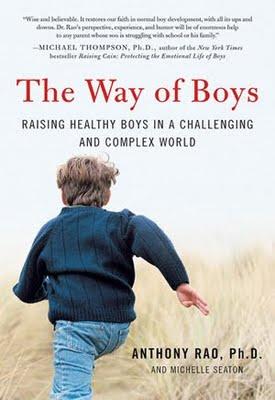The Way of Boys: Raising Healthy Boys in a Challenging and Complex World

Having raised daughters and taught young girls, I know what is required to be competent in those roles. The nature and needs of boys, however, were foreign to me. I had very little experience with the care and nurturing of very young boys. I naively and wrongly presumed that a child’s gender was of little, if any, consequence affecting the parent/teacher role. In reality, infancy seems to be the only time of relative equality. Once these tiny beings begin developing skills of locomotion and communication, the gender dichotomy begins in earnest. It is at this point in development that one needs to understand fully just how inherently different boys are in all that is their journey toward maturity.
In this little gem of a book, Rao and Seaton gave me a wonderful look into this heretofore alien world. They present a wealth of boy knowledge in an anecdotal style, making this book an enjoyable read. The focus is predominantly on boys between two and seven years old, the time when most behavior problems arise. The authors clearly present methods to help caretakers address discipline and training issues successfully. Simply put, boys are not girls. We cannot successfully raise both genders from the same perspective. Boys tend to lag behind girls in skills acquisition, particularly language. Unfortunately, developmental expectations are lumped in somewhat generic lists of milestones, and herein lies the beginning of the unintentional assault on development in male children. It is the profound difference in thought process combined with the imperative need to expend energy that makes raising and educating boys much more challenging.
After a general introduction into the nature of boys, the text flows through the myriad of troubling behaviors that plague social and educational settings (e.g., making friends, bullying, competitiveness, fantasizing). The authors then set about guiding the reader through the problems associated with limiting physical activity and the tendency to perceive natural boy behavior as a sickness that must be wrangled with medication. They also offer parents solid guidance to help them in determining that which is in the best interest of the child when presented with fearful scenarios by educators and school administrators. The final chapter is a delightful light-at-the-end-of-the-tunnel view, looking at some of the grown boys who had been youthful patients of Dr. Rao.
The Way of Boys is an absolute must read for anyone raising, educating, counseling, treating, and/or advocating for boys. Early-education teachers—who tend to be female—and mothers of boys need to be cognizant of the dynamic differences and be accommodating in the process so as not to stifle genuine development by trying to fit the proverbial square peg into a round hole. Boys are looking for the system, figuring things out, pushing the boundaries, and expending excessive energy in all that they do. I glimpsed this firsthand when I took my two-year-old grandson on an errand to the bank recently. He busied himself grabbing for, inspecting, and enthusiastically throwing the pens provided for patrons. Before reading this book, I would have been frustrated by this ill-mannered child. My girls NEVER did such at that age. By having this new knowledge, I was able to see him not as a bad child, but as a b-o-y. He taught me that I had to plan differently for him to avoid such temptations. I could not be mad with him for being male. This is what they do and how they think, and I love him for it.
I like the fair assessment that boys can not be raised like girls. The society we are in says that we raise both sexes the same and it not possible because both sexes are biologically different and that impacts things. I'm a male who has taught all ages of from toddlers to college students. Males operate differently inside the classroom. Giving males different activities that was just as challenging ended up closing some of the grade gap between girls, who excel more, and boys, who often lag behind. Often applied education in the means of an activity with them explaining why things works is better then tell them to sit down and do an activity. From science, math, social studies, and reading getting an outlet for male energy is essential in their educational development. Thanks for the article.